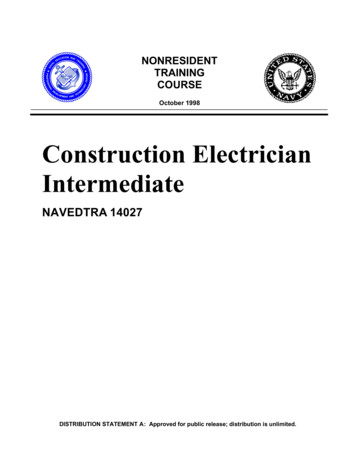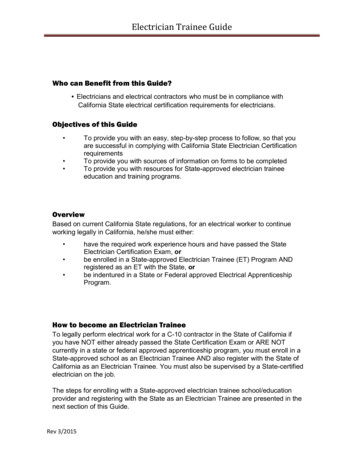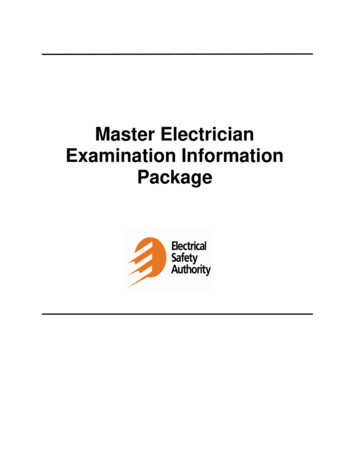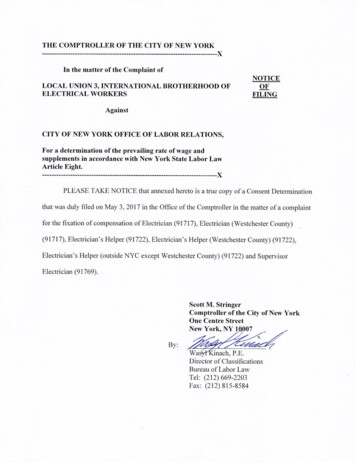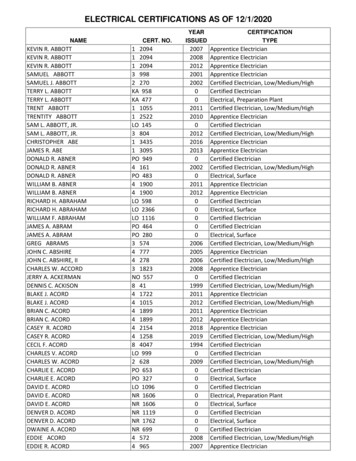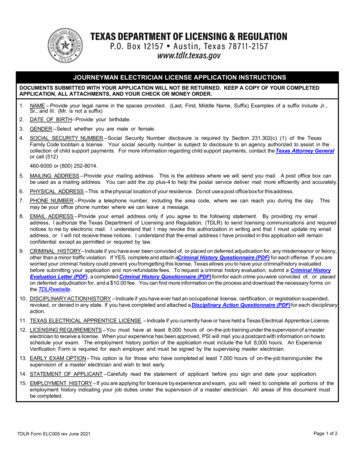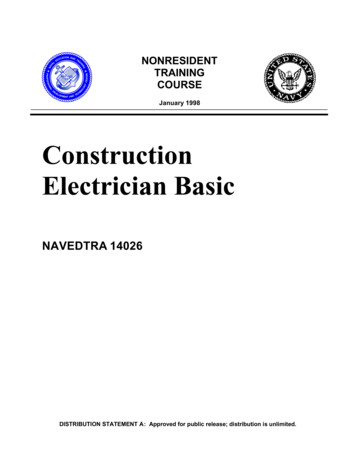
Transcription
NONRESIDENTTRAININGCOURSEJanuary 1998ConstructionElectrician BasicNAVEDTRA 14026DISTRIBUTION STATEMENT A: Approved for public release; distribution is unlimited.
Although the words “he,” “him,” and“his” are used sparingly in this course toenhance communication, they are notintended to be gender driven or to affront ordiscriminate against anyone.DISTRIBUTION STATEMENT A: Approved for public release; distribution is unlimited.
PREFACEBy enrolling in this self-study course, you have demonstrated a desire to improve yourself and the Navy.Remember, however, this self-study course is only one part of the total Navy training program. Practicalexperience, schools, selected reading, and your desire to succeed are also necessary to successfully roundout a fully meaningful training program.THE COURSE: This self-study course is organized into subject matter areas, each containing learningobjectives to help you determine what you should learn along with text and illustrations to help youunderstand the information. The subject matter reflects day-to-day requirements and experiences ofpersonnel in the rating or skill area. It also reflects guidance provided by Enlisted Community Managers(ECMs) and other senior personnel, technical references, instructions, etc., and either the occupational ornaval standards, which are listed in the Manual of Navy Enlisted Manpower Personnel Classificationsand Occupational Standards, NAVPERS 18068.THE QUESTIONS: The questions that appear in this course are designed to help you understand thematerial in the text.VALUE: In completing this course, you will improve your military and professional knowledge.Importantly, it can also help you study for the Navy-wide advancement in rate examination. If you arestudying and discover a reference in the text to another publication for further information, look it up.1998 Edition Prepared byCECS Jose Vicente P. FerriolsPublished byNAVAL EDUCATION AND TRAININGPROFESSIONAL DEVELOPMENTAND TECHNOLOGY CENTERNAVSUP Logistics Tracking Number0504-LP-026-7040i
Sailor’s Creed“I am a United States Sailor.I will support and defend theConstitution of the United States ofAmerica and I will obey the ordersof those appointed over me.I represent the fighting spirit of theNavy and those who have gonebefore me to defend freedom anddemocracy around the world.I proudly serve my country’s Navycombat team with honor, courageand commitment.I am committed to excellence andthe fair treatment of all.”ii
CONTENTSPAGECHAPTER1. Construction Support. . . . . . . . . . . . . . . . . . . . . . . . 1-12. Drawings and Specifications . . . . . . . . . . . . . . . . . . . . 2-13. Power Generation. . . . . . . . . . . . . . . . . . . . . . . . . . 3-14. Power Distribution . . . . . . . . . . . . . . . . . . . . . . . . . 4-15. Interior Wiring . . . . . . . . . . . . . . . . . . . . . . . . . . . 5-16. Communications and Lighting . . . . . . . . . . . . . . . . . . . 6-17. Electrical Appliances, Test Equipment, Motors, andGenerators. . . . . . . . . . . . . . . . . . . . . . . . . . . . . . 7-1APPENDIXI. Glossary . . . . . . . . . . . . . . . . . . . . . . . . . . . . . . AI-1II. Metric Conversion Tables . . . . . . . . . . . . . . . . . . . . AII-1III. Formulas. . . . . . . . . . . . . . . . . . . . . . . . . . . . . AIII-1IV. Hand Signals. . . . . . . . . . . . . . . . . . . . . . . . . . . AIV-1V. References Used to Develop the TRAMAN . . . . . . . . . . . AV-1INDEX. INDEX-1NONRESIDENT TRAINING COURSE follows the indexiii
SUMMARY OF THECONSTRUCTION ELECTRICIANTRAINING SERIESCONSTRUCTION ELECTRICIAN BASICThis training manual (TRAMAN) replaces Construction Electrician 3 andshould be studied by those seeking advancement to Construction Electrician ThirdClass.CONSTRUCTION ELECTRICIAN INTERMEDIATEThis TRAMAN, when published (refer to NAVEDTRA 12061 for availability),will replace Construction Electrician 3 & 2 and should be studied by those seekingadvancement to Construction Electrician Second Class. Topics in this book will be acontinuation of information covered in the Construction Electrician BasicTRAMAN.CONSTRUCTION ELECTRICIAN ADVANCEDThis TRAMAN, when published (refer to NAVEDTRA 12061 for availability),will replace Construction Electrician 1 and should be studied by those seekingadvancement to Construction Electrician First Class. Topics in this book will be acontinuation of information covered in the Construction Electrician IntermediateTRAMAN.iv
INSTRUCTIONS FOR TAKING THE COURSEASSIGNMENTSassignments. To submit youranswers via the Internet, go to:The text pages that you are to study are listed atthe beginning of each assignment. Study thesepages carefully before attempting to answer thequestions. Pay close attention to tables andillustrations and read the learning objectives.The learning objectives state what you should beable to do after studying the material. Answeringthe questions correctly helps you accomplish theobjectives.http://courses.cnet.navy.milGrading by Mail: When you submit answersheets by mail, send all of your assignments atone time. Do NOT submit individual answersheets for grading. Mail all of your assignmentsin an envelope, which you either provideyourself or obtain from your nearest EducationalServices Officer (ESO). Submit answer sheetsto:SELECTING YOUR ANSWERSCOMMANDING OFFICERNETPDTC N3316490 SAUFLEY FIELD ROADPENSACOLA FL 32559-5000Read each question carefully, then select theBEST answer. You may refer freely to the text.The answers must be the result of your ownwork and decisions. You are prohibited fromreferring to or copying the answers of others andfrom giving answers to anyone else taking thecourse.Answer Sheets: All courses include one“scannable” answer sheet for each assignment.These answer sheets are preprinted with yourSSN, name, assignment number, and coursenumber. Explanations for completing the answersheets are on the answer sheet.SUBMITTING YOUR ASSIGNMENTSTo have your assignments graded, you must beenrolled in the course with the NonresidentTraining Course Administration Branch at theNaval Education and Training ). Following enrollment, there aretwo ways of having your assignments graded:(1) use the Internet to submit your assignmentsas you complete them, or (2) send all theassignments at one time by mail to NETPDTC.Grading on the Internet:Internet grading are: assignmentDo not use answer sheet reproductions: Useonly the original answer sheets that weprovide— reproductions will not work with ourscanning equipment and cannot be processed.Follow the instructions for marking youranswers on the answer sheet. Be sure that blocks1, 2, and 3 are filled in correctly. Thisinformation is necessary for your course to beproperly processed and for you to receive creditfor your work.Advantages toCOMPLETION TIMEyou may submit your answers as soon asyou complete an assignment, andyou get your results faster; usually by thenext working day (approximately 24 hours).Courses must be completed within 12 monthsfrom the date of enrollment. This includes timerequired to resubmit failed assignments.In addition to receiving grade results for eachassignment, you will receive course completionconfirmation once you have completed all thev
PASS/FAIL ASSIGNMENT PROCEDURESFor subject matter questions:If your overall course score is 3.2 or higher, youwill pass the course and will not be required toresubmit assignments. Once your assignmentshave been graded you will receive coursecompletion milComm: (850) 452-1001, Ext. 1826DSN: 922-1001, Ext. 1826FAX: (850) 452-1370(Do not fax answer sheets.)Address: COMMANDING OFFICERNETPDTC (CODE 314)6490 SAUFLEY FIELD ROADPENSACOLA FL 32509-5237If you receive less than a 3.2 on any assignmentand your overall course score is below 3.2, youwill be given the opportunity to resubmit failedassignments. You may resubmit failedassignments only once. Internet students willreceive notification when they have failed anassignment--they may then resubmit failedassignments on the web site. Internet studentsmay view and print results for failedassignments from the web site. Students whosubmit by mail will receive a failing result letterand a new answer sheet for resubmission of eachfailed assignment.For enrollment, shipping,completion letter .navy.milToll Free: 877-264-8583Comm: (850) 452-1511/1181/1859DSN: 922-1511/1181/1859FAX: (850) 452-1370(Do not fax answer sheets.)Address: COMMANDING OFFICERNETPDTC (CODE N331)6490 SAUFLEY FIELD ROADPENSACOLA FL 32559-5000COMPLETION CONFIRMATIONAfter successfully completing this course, youwill receive a letter of completion.NAVAL RESERVE RETIREMENT CREDITERRATAhttp://www.advancement.cnet.navy.milIf you are a member of the Naval Reserve, youwill receive retirement points if you areauthorized to receive them under currentdirectives governing retirement of NavalReserve personnel. For Naval Reserveretirement, this course is evaluated at 9 points.(Refer to Administrative Procedures for NavalReservists on Inactive Duty, BUPERSINST1001.39, for more information about retirementpoints.)STUDENT FEEDBACK QUESTIONSCOURSE OBJECTIVESWe value your suggestions, questions, andcriticisms on our courses. If you would like tocommunicate with us regarding this course, weencourage you, if possible, to use e-mail. If youwrite or fax, please use a copy of the StudentComment form that follows this page.In completing this nonresident training course,you will demonstrate a knowledge of the subjectmatter by correctly answering questions on thefollowing subjects: Construction Support,Drawings and Specifications, Power Generation,Power Distribution, Interior Wiring, Communications and Lighting, and Electrical Appliances,Test Equipment, Motors, and Generators.Errata are used to correct minor errors or deleteobsolete information in a course. Errata mayalso be used to provide instructions to thestudent. If a course has an errata, it will beincluded as the first page(s) after the front cover.Errata for all courses can be accessed andviewed/downloaded at:vi
Student CommentsCourse Title:Construction Electrician BasicNAVEDTRA:14026Date:We need some information about you:Rate/Rank and Name:SSN:Command/UnitStreet Address:City:State/FPO:ZipYour comments, suggestions, etc.:Privacy Act Statement: Under authority of Title 5, USC 301, information regarding your military status isrequested in processing your comments and in preparing a reply. This informationwill not be divulged withoutwritten authorization to anyone other than those within DOD for official use in determining performance.NETPDTC 1550/41 (Rev 4-00)vii
CHAPTER 1CONSTRUCTION SUPPORTof these lines depends on their size, the fiber used, andthe type of stranding.As a Construction Electrician you will be involvedin many aspects of construction work. This chaptertouches on a few of these, such as rigging and hoisting,equipment movement, hazardous material,embarkation, and tool kits. Although this chapter doesnot deal with electrical work, you need to study andrefer back to this chapter for your safety and the safetyof your shipmates.Uncoiling LineNew line is coiled, bound, and wrapped. Theprotective covering should not be removed until the lineis to be used. This covering will protect the line duringstowage and prevent tangling. To open, strip off theouter wrapping and look inside the coil for the end of theline. This should be at the bottom of the coil. If not, turnthe coil over so that the end will be at the bottom, asshown in figure 1-1. Pull the end of the line up throughthe center of the coil. As the line comes up through thecoil, it will unwind in a counterclockwise direction.USING LINES AND SLINGSThe safety of personnel involved in rigging andhoisting operations largely depends upon care andcommon sense. Equally important is the properselection of lines and slings for safe and stable lifts.Whipping LineINSPECTIONSThe term whipping refers to the process of securingthe ends of a line to prevent the strands from unravelingand the yarns from separating or fraying. Whippingsare made from fine twine and will not increase the sizeof the line enough to prevent it from fitting the blocks oropenings.The single most important operational check to bemade on hoisting and rigging equipment is the line andrigging inspection. Such factors as abrasion, wear,fatigue, corrosion, and kinking are of great significancein determining usable life.The only way to determine the safety of a line, itslife expectancy, and its load-carrying ability is byregularly inspecting every foot of its length. The mainpoints to watch for are external wear and cutting,internal wear between the strands, and deterioration ofthe fibers.Figure 1-2 shows the steps to follow in applying awhipping. Make a loop in the end of the twine and placeFIBER LINESFiber lines are made from either natural or syntheticfibers. The natural fibers come from plants and includemanila, sisal, and hemp. The synthetic fibers includenylon, polypropylene, and the polyesters. The strengthFigure 1-1.—Removing line from a shipping coil.Figure 1-2.—Proper way to apply a line whipping.l-l
Strength of Fiber Linethe loop at the end of the line, as shown in the figure.Wind the standing part around the line covering the loopof the whipping. Leave a small loop uncovered, asshown. Pass the remainder of the standing end upthrough the small loop and pull the dead end of thetwine, thus pulling the small loop and the standing endback towards the end of the line underneath thewhipping. Pull the dead end of the twine until the loopwith the standing end reaches a point midwayunderneath the whipping. Trim both ends of the twineclose up against the loops of the whipping. Beforecutting a line, place two whippings on the line 1 or 2inches apart and make the cut between the whippings.This will prevent the ends from unraveling after they arecut.Overloading a line poses a serious threat to thesafety of personnel, not to mention the heavy losseslikely to result through damage to material. To avoidoverloading, you must know the strength of the line youare working with. This involves three factors: breakingstrength, safe working load, and safety factor.BREAKING STRENGTH.—Refers to thetension at which the line will part when a load is applied.Line manufacturers have determined breaking strengththrough tests and have set up tables to provide thisinformationSAFE WORKING LOAD—Briefly defined, the"safe working load" (SWL) of a line is the load that canbe applied without causing any kind of damage to theline. Note that the safe working load is considerablyless than the breaking strength. A wide margin ofdifference between breaking strength and safe workingload is necessary to allow for such factors as additionalstrain imposed on the line by jerky movements inhoisting or bending over sheaves in a pulley block.Stowing LineBefore stowing a fiber line, you must take certainprecautions to safeguard the line against deterioration.You should never stow a wet line. Always dry the linewell before placing it in stowage.SAFETY FACTOR.— safety factor of a line isthe ratio between the breaking strength and the safeworking load. Usually, a safety factor of 4 is acceptable,but this is not always the case. In other words, the safetyfactor will vary, depending on such things as thecondition of the line and circumstances under which it isto be used. While the safety factor should NEVER beless than 3, it often should be well above 4 (possibly ashigh as 8 or 10). For best, average, or unfavorableconditions, the safety factor indicated below may oftenbe suitable.After a line has been used, you should coil it downin a clockwise direction (assuming it is a right-handlay). Should the line be kinked from excessive turns,remove the kinks by the procedure known as "thoroughfooting." You do this by coiling the line downcounterclockwise and then pulling the bottom end of thecoil up and out the middle of the coil. If the line is free ofkinks as it leaves the coil, make it up in the correctmanner. If it is still kinked, repeat the process beforemaking up the line for stowage.BEST conditions (new line): 4AVERAGE conditions (line used but in goodcondition): 6Choose your stowage space for line carefully. Linedeteriorates rapidly if exposed to prolonged dampness.Furthermore, it is important for the stowage area to bedry, unheated, and well ventilated. To permit proper aircirculation, you should either place the line in loosecoils on a wood grating platform about 6 inches (15 cm)above the floor or hang the line in loose coils on awooden peg.UNFAVORABLE conditions (frequently used line,such as running rigging): 8Table 1-1 lists some of the properties of manila andsisal line, including strength. The table shows that theminimum breaking strength is considerably greater thanthe safe working capacity. The difference is caused bythe application of a safety factor. The safe working load(SWL) of line is obtained by dividing the breakingstrength (BS) by a factor of safety (FS). A new 1-inchdiameter No. 1 manila line has a breaking strength of9,000 pounds, as indicated in table l-l. To determinethe safe working load of the line, you would divide itsbreaking strength by a minimum standard safety factorYou should NEVER expose a line to lime, acids, orother chemicals, or even stow it in a room containingchemicals. Even the vapors may severely damage line.As a final precaution, avoid continually exposing line tosunlight. Excessive sunlight will also damage the line.1-2
of 4. The result is an SWL of 2,250 pounds. A safetyfactor is always used because the breaking strength ofline be comes reduced after use and exposure toweather conditions. In addition, a safety factor isrequired because of shock loading, knots, sharp bends,and other stresses that the line may encounter during itsuse.If tables are not available, the SWL may be closelyapproximated by a rule of thumb. The rule of thumb forthe SWL, in tons, for fiber line is equal to the square of2the line diameter in inches (SWL D ). The SWL, intons, of a 1/2-inch-diameter fiber line would be 1/2 inchsquared or 1/4 ton. The rule of thumb allows a safetyfactor of approximately 4.SYNTHETIC-FIBER LINESSynthetic-fiber lines, such as nylon and polyester,have rapidly gamed wide use by the Navy. They arelighter in weight, more flexible, less bulky, and easier tohandle and stow than manila lines. Also, they are highlyresistant to mildew, rot, and fungus. Synthetic lines arestronger than natural-fiber line; for example, nylon isabout three times stronger than manila. When nylon lineis wet or frozen, the loss of strength is relatively small.Nylon line will hold a load, even though several strandsmay be frayed. Ordinarily, the line can be madereusable by cutting away the chafed or frayed sectionand splicing the good line together.Table 1-1.—Properties of Manila and Sisal 43/43/8Lb per ftSisalNo. 1 ManilaBreakingstrength(pounds)Safeload(pounds)F.S. 4Breakingstrength(pounds)Safeload(pounds)F.S. 4.0206001504801201 1/8.0401,3503251,0802601/21 /42 1/4.1675,4001,3504,3201,0807/82 8001 1/83 1/2.36012,0003,0009,6002,4001 1/43 3/4.41813,5003,38010,8002,7001 1/24 1/2.60018,5004,62014,8003,7001 3/45 006,2002 1/27 ,20012,8001-3
Tables 1-2 and 1-3 list the approximate safe working loads of new fiber lines with a safety factor of 5.For polypropylene line, multiply the diameter by40, and for polyethylene, by 35.NOTE: These are for reference only. Check themanufacturer’s ratings before determining the safeworking loads, as they may differ from the tables.Remember that the strength of a line decreases withage, use, and exposure to excessive heat, boiling water,or sharp bends. Especially with used line, you shouldgive these and other factors affecting strength carefulconsideration and make proper adjustment in thebreaking strength and SWL of the line.You may not always have a chart available to tellyou the safe working load for a particular size of line.There is a rule of thumb that will adequately serve yourneeds on such an occasion. The formulas below areexamples of synthetic fiber lines used for rigging, notslings.WIRE ROPEDuring the course of a career, CEs often need tohoist or move heavy objects. Wire rope is used forheavy-duty work. In the following paragraphs, we willdiscuss the characteristics, construction, and usage ofmany types of wire rope as well as the safe workingload, use of attachments and fittings, and procedures forthe care and handling of wire rope.For nylon or polyester line, change the linediameter into eighths of an inch, square the numerator,and multiply by 60.Example: 1/2-inch nylon line 4/8-inch diameterSWL 4 x 4 x 60 960 lbTable 1-2.—Safe Working Load of Fiber LineAPPROXIMATE SAFE WORKING LOADS OF NEW FIBER LINES — POUNDSThree-Strand LineSafety Factor 5Nominal ,8002,9004,2002,5001 1/82,4006,3003,7505,6003,3001 1/42,7007,2004,2006,3003,7001 1/23,70010,2006,0008,9005,3001 5/84,50012,4007,30010,8006,5001 ,2009,5001-4
Table 1-3.—Safe Working Load of Braided Synthetic Fiber LineAPPROXIMATE SAFE WORKING LOADS OF NEWBRAIDED SYNTHETIC FIBER LINES (LB)SAFETY FACTOR 5Nominal LineDiameter(inches)1/4Nylon CoverNylon CoreNylon CoverPolypropylene CorePolyester CoverPolypropylene 2,1002,4003/43,5003,2002,8607/84,8004,1503,8001 1/85,7008,0004,8007,0005,600—1 1/148,8008,000—1 1/212,80012,400—1 5/816,00014,000—1 3/419,40018,000—223,60020,000—1Wire rope that is made up of a large number of smallwires is flexible. The small wires are, however, easilybroken, so the wire rope does not resist externalabrasion. Wire rope that is made up of a smaller numberConstructionWiie rope consists of three parts: wires, strands,and core (fig. 1-3). In the manufacture of wire rope, anumber of WIRES are laid together to form theSTRAND. Then a number of STRANDS are laidtogether around a CORE to form the wire ROPE.The basic unit of wire-rope construction is theindividual wire, which may be made of steel, iron, orother metal in various sixes. The number of wires to astrand will vary, dependingonthepurpose for which thewire rope is intended. Wiie rope is designated by thenumber of strands per rope and the number of wires perstrand. Thus a 1/2-inch, 6 by 19 wire rope will have sixstrands with 19 wires per strand; but it will have thesame outside diameter as a 1/2-inch, 6 by 37 wire rope,which will have six strands with 37 wires of muchsmaller size per strand.Figure 1-3.—Parts of a wire rope.1-5
of larger wires is more resistant to external abrasion butis less flexible.strand, is the most flexible of the standard six-strandwire ropes. For that reason, it is particularly suitablewhen you are going to use small sheaves and drums,such as are used on cranes and similar machinery.The CORE, the element around which the strandsare laid to form the wire rope, may be of hard fiber, suchas manila, hemp, plastic, paper, or sisal. Also, a wirestrand core may be used. Each type of core serves thesame basic purpose—to support the strands laid aroundit.Grades of Wire RopeWire rope is made in a number of different grades,three of which are mild-plow steel, plow steel, andimproved-plow steel.A FIBER CORE offers the advantage of increasedflexibility. Also, it serves as a cushion to reduce theeffects of sudden strain and acts as a reservoir for the oilto lubricate the wires and strands to reduce frictionbetween them. Wire rope with a fiber core is used inplaces where flexibility of the wire rope is important.MILD-PLOW STEEL wire rope is tough andpliable. It can stand up under repeated strain and stress,and it has a tensile strength of 200,000 to 220,000pounds per square inch (psi).PLOW STEEL wire rope is unusually tough andstrong. This steel has a tensile strength (resistance tolengthwise stress) of 220,000 to 240,000 psi. This wirerope is suitable for hauling, hoisting, and logging.A WIRE-STRAND CORE not only resists heatbetter than a fiber core but it also adds about 15 percentto the strength of the wire rope. On the other hand, thewire strand makes the wire rope less flexible than a fibercore would.IMPROVED-PLOW STEEL wire rope is one of thebest grades of wire rope available, and most, if not all, ofthe wire rope you will use in your work will probably bemade of this material. It is stronger, tougher, and moreresistant to wear than either plow steel or mild-plowsteel. Each square inch of improved-plow steel canstand a strain of 240,000 to 260,000 psi.An INDEPENDENT WIRE-ROPE CORE is aseparate wire rope over which the main strands of thewire rope are laid. It usually consists of six seven-wirestrands laid around either a fiber core or a wire-strandcore. This core strengthens the wire rope more,provides support against crushing, and suppliesmaximum resistance to heat.Measuring Wire RopeThe size of wire rope is designated by its diameter.The true diameter of a wire rope is considered as beingthe diameter of the circle that will just enclose all of itsstrands. Both the correct and incorrect methods ofmeasuring wire rope are shown in figure 1-5. Note, inparticular, that the CORRECT WAY is to measure fromthe top of one strand to the top of the strand directlyopposite it. Use calipers to take the measurement; ifcalipers are not available, an adjustable wrench will do.Wire rope may be made by either of two methods.If the strands or wires are shaped to conform to thecurvature of the finished wire rope before laying up, thewire rope is termed preformed. If they are not shapedbefore fabrication, the wire rope is termednonpreformed. When cut, preformed wire rope tendsnot to unlay, and it is more flexible than nonpreformedwire rope. With nonpreformed wire rope, twistingproduces a stress in the wires; and, when it is cut orbroken, the stress causes the strands to unlay. Innonpreformed wire rope, unlaying is rapid and almostinstantaneous, which could cause serious injury tosomeone not familiar with it.To ensure an accurate measurement of the diameterof a wire rope, always measure the wire rope at threeThe main types of wire rope used by the Navy have6, 7, 12, 19, 24, or 37 wires in each strand. Usually, thewire rope has six strands laid around a fiber or steelcenter.Two common types of wire rope, 6 by 19 and 6 by37 wire rope, are shown in figure 1-4. The 6 by 19 typeof wire rope, having six strands with 19 wires in eachstrand, is commonly used for rough hoisting andskidding work where abrasion is likely to occur. The 6by 37 wire rope, having six strands with 37 wires in eachFigure 1-4.—Two types of wire rope.1-6
a 1/2-inch-diameter wire rope. Using the formulaabove, you would solve the problem as follows:2SWL (1/2) x 8SWL 2 tonsWIRE-ROPE ATTACHMENTSWire rope can be attached to other wire ropes,chains, pad eyes, or equipment by splicing, which ispermanent, or by any of a number of wire-ropeattachments. These include sockets and wire-ropeclips. In general, these attachments permit the wire ropeto be used with greater flexibility than would bepossible with a more permanent splice. Theattachments allow the same wire rope to be made up in avariety of different arrangements.ClipsA temporary eye splice may be put in wire rope byusing clips. A single clip (fig. 1-6) consists of threeparts: U-bolt, saddle, and nuts. The correct andincorrect methods of applying these clips to wire ropeare shown in figure 1-6; the second incorrect methodshown is the most common. Notice that the correct wayis to apply the clips so that the U-bolts bear against thebitter end; that is, the short end of the wire rope. If theclips are attached incorrectly, the result will bedistortion or mashed spots on the live end of the wirerope. After a wire rope is under strain, tighten the clipsagain. On operating wire ropes, tighten the clips dailyand inspect the wire ropes carefully at points whereFigure 1-5.—Correct and incorrect methods of measuringwire rope.places on a six-stranded, and four places on an eightstranded wire rope. Use the average of the threemeasurements as the diameter of the wire rope.Safe Working LoadThe term safe working load (SWL), as used inreference to wire rope, means the load that you canapply and still obtain the most efficient service and alsoprolong the life of the wire rope. Most manufacturersprovide tables that show the safe working load for theirwire rope under various conditions. In the absence ofthese tables, you may apply the following rule-ofthumb formula to obtain the SWL:2SWL (in tons) D x 8This particular formula provides an ample marginof safety to account for such variables as the number,size, and location of sheaves and drums on which thewire rope runs and such dynamic stresses as the speed ofoperation and the acceleration and deceleration of theload, all of which can affect the endurance and breakingstrength of the wire rope. Remember this formula is ageneral computation, and you should also consider theoverall condition of the wire rope.In the above formula, D represents the diameter ofthe rope in inches. Suppose you want to find the SWL ofFigure 1-6.—Use of wire-rope clips.1-7
there are clips. Pay particular attention to the wire at theclip farthest from t
continuation of information covered in the Construction Electrician Basic TRAMAN. CONSTRUCTION ELECTRICIAN ADVANCED This TRAMAN, when published (refer to NAVEDTRA 12061 for availability), will replace Construction Electrician 1 and should be studied by those seeking advancement to Constru
